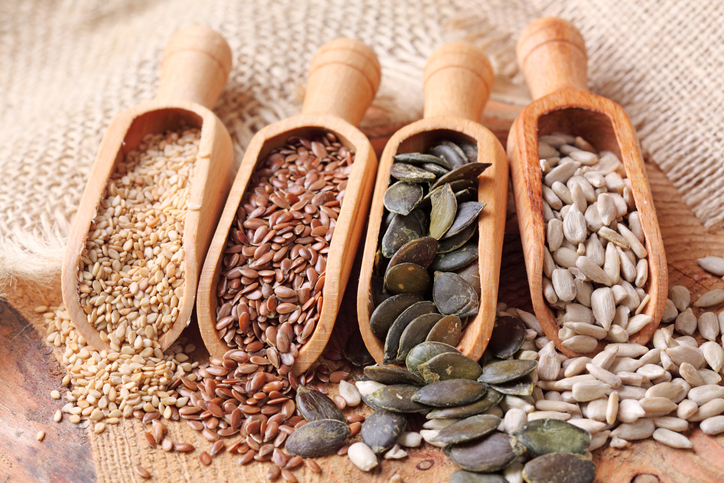Seed cycling is a natural therapy that involves consuming specific types of seeds during different phases of the menstrual cycle to help regulate hormones. This practice has gained popularity as a holistic approach to managing hormonal imbalances, menstrual irregularities, and symptoms related to menopause and premenstrual syndrome (PMS). The concept is simple: by incorporating certain seeds into your diet at specific times of the month, you can support the natural hormonal fluctuations in your body.

Understanding the Menstrual Cycle
Before delving into seed cycling, it’s important to understand the basics of the menstrual cycle. The cycle is typically divided into two main phases:
1.Follicular Phase (Day 1 to 14):
This phase begins on the first day of menstruation and continues until ovulation. During this time, estrogen levels gradually rise, leading to the maturation of follicles in the ovaries.
2. Luteal Phase (Day 15 to 28):
Following ovulation, the luteal phase begins. Progesterone levels increase to prepare the uterine lining for a potential pregnancy. If pregnancy does not occur, both estrogen and progesterone levels drop, leading to menstruation and the start of a new cycle.
How Seed Cycling Works
Seed cycling involves consuming flaxseeds and pumpkin seeds during the follicular phase, and sesame seeds and sunflower seeds during the luteal phase. These seeds are chosen for their specific properties and nutrient profiles that support the hormonal needs of each phase.
Follicular Phase: Flaxseeds and Pumpkin Seeds
– Flaxseeds:
These seeds are rich in lignans, which are compounds that can help balance estrogen levels. They also contain omega-3 fatty acids, which reduce inflammation and support overall hormonal health. By consuming flaxseeds during the follicular phase, you can help ensure a healthy balance of estrogen as it rises.
– Pumpkin Seeds:
Pumpkin seeds are high in zinc, which supports the production of progesterone. They also contain phytoestrogens, which can help modulate estrogen levels. Including pumpkin seeds in your diet during the follicular phase can help prepare your body for the shift to the luteal phase and the production of progesterone.
Luteal Phase: Sesame Seeds and Sunflower Seeds
– Sesame Seeds:
Sesame seeds are another excellent source of lignans, which help balance estrogen levels. They are also rich in essential fatty acids and other nutrients that support hormonal health. Consuming sesame seeds during the luteal phase can help manage estrogen and progesterone levels.
– Sunflower Seeds:
These seeds are high in vitamin E, which is crucial for progesterone production. They also contain selenium, which supports liver function and hormone metabolism. Adding sunflower seeds to your diet during the luteal phase helps maintain healthy progesterone levels and supports the overall hormonal balance.

Benefits of Seed Cycling
Seed cycling is praised for its potential benefits, particularly for women experiencing hormonal imbalances. Some of the key benefits include:
1. Hormonal Balance:
By providing specific nutrients that support estrogen and progesterone production, seed cycling can help balance hormones and reduce symptoms of hormonal imbalances, such as irregular periods, acne, and mood swings.
2. PMS Relief:
Many women find that seed cycling helps alleviate common PMS symptoms like bloating, breast tenderness, and irritability. The nutrients in the seeds support the body’s natural hormonal fluctuations, making the menstrual cycle more predictable and manageable.
3. Menopause Symptom Management:
For women approaching menopause, seed cycling can help ease the transition by supporting hormonal balance. The phytoestrogens in flaxseeds and sesame seeds can mimic estrogen in the body, potentially reducing hot flashes and other menopausal symptoms.
4. Improved Fertility:
By regulating hormones and supporting a healthy menstrual cycle, seed cycling may improve fertility for women trying to conceive. Balanced estrogen and progesterone levels are crucial for ovulation and a healthy reproductive system.
5. Enhanced Digestion and Metabolism:
Seeds are rich in fiber, healthy fats, and essential nutrients that support digestion and overall metabolic health. Incorporating them into your diet can improve gut health and nutrient absorption, further supporting hormonal balance.
How to Implement Seed Cycling
Implementing seed cycling is straightforward and involves adding the recommended seeds to your diet at the appropriate times in your cycle. Here’s a simple guide to get started:
Follicular Phase (Day 1 to 14)
– Flaxseeds: 1 tablespoon per day
– Pumpkin Seeds: 1 tablespoon per day
Luteal Phase (Day 15 to 28)
– Sesame Seeds: 1 tablespoon per day
– Sunflower Seeds: 1 tablespoon per day
You can consume the seeds in various forms: whole, ground, or as part of meals and snacks. Some easy ways to incorporate them include adding them to smoothies, yogurt, salads, oatmeal, or baking them into bread and muffins.
Tips for Successful Seed Cycling
1.Consistency is Key:
For seed cycling to be effective, it’s important to be consistent. Make it a daily habit to consume the seeds during the specified phases of your cycle.
2. Freshness Matters:
Use fresh, high-quality seeds. Grinding the seeds can help improve nutrient absorption. Store them in an airtight container in the refrigerator to maintain freshness.
3. Listen to Your Body:
Pay attention to how your body responds to seed cycling. While many women experience positive changes, it may take a few months to notice significant differences. If you have any adverse reactions, consult a healthcare professional.
4. Combine with a Healthy Lifestyle:
Seed cycling is most effective when combined with a healthy lifestyle. Ensure you are eating a balanced diet, staying hydrated, getting regular exercise, and managing stress.
Conclusion
Seed cycling is a natural and holistic approach to supporting hormonal health. By incorporating specific seeds into your diet at different phases of your menstrual cycle, you can help balance estrogen and progesterone levels, reduce PMS symptoms, manage menopause, and improve overall reproductive health. While it may take some time to see the full benefits, many women find seed cycling to be a valuable addition to their wellness routine. As always, consult with a healthcare provider before making significant changes to your diet or health regimen.





1 Comment
Hey people!!!!!
Good mood and good luck to everyone!!!!!